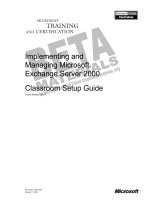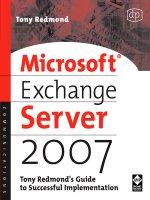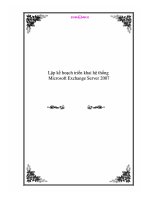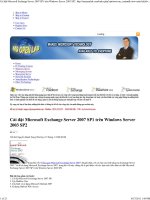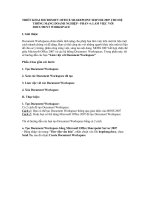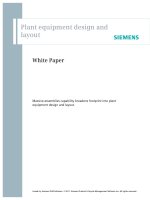MCITP Microsoft Exchange Server 2007 Messaging Design and Deployment Study Guide phần 1 pptx
Bạn đang xem bản rút gọn của tài liệu. Xem và tải ngay bản đầy đủ của tài liệu tại đây (2.71 MB, 98 trang )
Wiley Publishing, Inc.
MCITP:
Microsoft
®
Exchange
Server 2007 Messaging
Design and Deployment
Study Guide
Rawlinson Rivera
81461ffirs.fm Page iii Thursday, December 13, 2007 9:52 AM
81461ffirs.fm Page ii Thursday, December 13, 2007 9:52 AM
MCITP:
Microsoft
®
Exchange
Server 2007 Messaging
Design and Deployment
Study Guide
81461ffirs.fm Page i Thursday, December 13, 2007 9:52 AM
81461ffirs.fm Page ii Thursday, December 13, 2007 9:52 AM
Wiley Publishing, Inc.
MCITP:
Microsoft
®
Exchange
Server 2007 Messaging
Design and Deployment
Study Guide
Rawlinson Rivera
81461ffirs.fm Page iii Thursday, December 13, 2007 9:52 AM
Acquisitions Editor: Jeff Kellum
Development Editor: Brenda Frink
Technical Editor: Rodney R. Fournier
Production Editor: Elizabeth Campbell
Copy Editor: Candace English
Production Manager: Tim Tate
Vice President and Executive Group Publisher: Richard Swadley
Vice President and Executive Publisher: Joseph B. Wikert
Vice President and Publisher: Neil Edde
Media Associate Project Supervisor: Laura Atkinson
Media Assistant Producer: Josh Frank
Media Quality Assurance: Angie Denny
Book Designers: Judy Fung and Bill Gibson
Compositor: Craig Woods, Happenstance Type-o-Rama
Proofreader: Amy McCarthy
Indexer: Ted Laux
Anniversary Logo Design: Richard Pacifico
Cover Designer: Ryan Sneed
Copyright © 2008 by Wiley Publishing, Inc., Indianapolis, Indiana
Published simultaneously in Canada
ISBN: 978-0-470-18146-1
No part of this publication may be reproduced, stored in a retrieval system or transmitted in any form or by any means,
electronic, mechanical, photocopying, recording, scanning or otherwise, except as permitted under Sections 107 or 108
of the 1976 United States Copyright Act, without either the prior written permission of the Publisher, or authorization
through payment of the appropriate per-copy fee to the Copyright Clearance Center, 222 Rosewood Drive, Danvers,
MA 01923, (978) 750-8400, fax (978) 646-8600. Requests to the Publisher for permission should be addressed to the
Legal Department, Wiley Publishing, Inc., 10475 Crosspoint Blvd., Indianapolis, IN 46256, (317) 572-3447, fax (317)
572-4355, or online at />Limit of Liability/Disclaimer of Warranty: The publisher and the author make no representations or warranties with
respect to the accuracy or completeness of the contents of this work and specifically disclaim all warranties, including
without limitation warranties of fitness for a particular purpose. No warranty may be created or extended by sales or
promotional materials. The advice and strategies contained herein may not be suitable for every situation. This work
is sold with the understanding that the publisher is not engaged in rendering legal, accounting, or other professional
services. If professional assistance is required, the services of a competent professional person should be sought. Neither
the publisher nor the author shall be liable for damages arising herefrom. The fact that an organization or Website is
referred to in this work as a citation and/or a potential source of further information does not mean that the author or
the publisher endorses the information the organization or Website may provide or recommendations it may make.
Further, readers should be aware that Internet Websites listed in this work may have changed or disappeared between
when this work was written and when it is read.
For general information on our other products and services or to obtain technical support, please contact our Customer
Care Department within the U.S. at (800) 762-2974, outside the U.S. at (317) 572-3993 or fax (317) 572-4002.
Wiley also publishes its books in a variety of electronic formats. Some content that appears in print may not be available
in electronic books.
Library of Congress Cataloging-in-Publication Data
Rivera, Rawlinson, 1976-
MCTIP : Microsoft Exchange Server 2007 messaging design and deployment study guide (70-237 and 70-238) /
Rawlinson Rivera.
p. cm.
ISBN 978-0-470-18146-1 (pbk. : CD-ROM)
1. Microsoft Exchange server. 2. Client/server computing. 3. Telecommunication Message processing. I. Title. II.
Title: Microsoft Exchange Server 2007 messaging design and deployment study guide.
QA76.9.C55R58 2007
005.7'1376 dc22
2007043722
TRADEMARKS: Wiley, the Wiley logo, and the Sybex logo are trademarks or registered trademarks of John Wiley &
Sons, Inc. and/or its affiliates, in the United States and other countries, and may not be used without written permission.
Microsoft is a registered trademark of Microsoft Corporation in the United States and/or other countries. All other
trademarks are the property of their respective owners. Wiley Publishing, Inc., is not associated with any product or
vendor mentioned in this book.
10 9 8 7 6 5 4 3 2 1
81461ffirs.fm Page iv Thursday, December 13, 2007 9:52 AM
Dear Reader,
Thank you for choosing
MCITP: Microsoft Exchange Server 2007 Messaging Design and
Deployment Study Guide
. This book is part of a family of premium quality Sybex books, all
written by outstanding authors who combine practical experience with a gift for teaching.
Sybex was founded in 1976. More than thirty years later, we’re still committed to producing
consistently exceptional books. With each of our titles we’re working hard to set a new standard
for the industry. From the paper we print on, to the authors we work with, our goal is to bring
you the best books available.
I hope you see all that reflected in these pages. I’d be very interested to hear your comments
and get your feedback on how we’re doing. Feel free to let me know what you think about
this or any other Sybex book by sending me an email at
. Or, if you think
you’ve found a technical error in this book, please visit
.
Customer feedback is critical to our efforts at Sybex.
Best regards,
Neil Edde
Vice President and Publisher
Sybex, an Imprint of Wiley
81461ffirs.fm Page v Thursday, December 13, 2007 9:52 AM
This book is dedicated to the loving memory of the people who have made a big
impact on my life by providing me with advice and guidance and by believing in me.
To Aurelio Rivera, Joe Lopez, John Camejo, and Frank Yautz, thanks for the oppor-
tunities and excellent advice. All of your help and guidance has made me a better
person and more efficient and successful in profession.
81461ffirs.fm Page vi Thursday, December 13, 2007 9:52 AM
Acknowledgments
I never thought that I would enjoy writing and teaching as much as I do now. In fact I love it. I enjoy
writing about existing technology, sharing my experiences with students and colleges everywhere.
I’ve trained people all around the world and it’s been a great experience, so great that I plan to con-
tinue doing it for as long as I live. There is no question that technology is my passion and I’m very
fortunate to live my passion.
I want to thank Chris McCain, my mentor for showing me the way and giving me the
opportunity to take part in so many great projects including writing this book. Now I can
share my passion with the rest of the world. Because of you, I had the privilege of being
involved in different capacities with Microsoft Learning in the development of the certification
and the courseware development for Exchange Server 2007, Windows Server 2008, Windows
Vista, WSS 3.0, and SharePoint Server 2007.
I learned during this project that writing a book of this magnitude is not easy and is time-
consuming. Writing books is never the product of a single person, but rather the collective effort
of many. I want to thank all the people who were involved with this project, Joel Stidley, Andy
Schan, Ilse Van Criekinge, Siegfried Jagott, Bob Lawler, and Tariq Azid. Your work, sacrifices, and
efforts are greatly appreciated. I’d like to thank the developmental editor Brenda Frink and the
technical editors, Rodney R. Fournier and Randy Muller, for providing constructive feedback and
detail suggestions. My thanks also go to the copy editor, Candace English; the production editor,
Elizabeth Campbell; the proofreader, Amy McCarthy; and to the compositor, Craig Woods.
A special thanks to Jeff Kellum and the staff at Wiley for the patience and the opportunity.
—Rawlinson Rivera
81461ffirs.fm Page vii Thursday, December 13, 2007 9:52 AM
About the Author
Rawlinson Rivera, an 11-year veteran of the IT consulting and training field, has worked with
a variety of technologies ranging from IBM to VMware to Microsoft. He has developed a
specialization in architecting secure messaging and collaboration infrastructures with Win-
dows Server 2000/2003, Office SharePoint Server 2007, Exchange Server 2000/2003/2007,
and VMware Virtual Infrastructure 3.
Rawlinson is a senior consultant of RawlsNet Technologies, LLC, a firm he founded that
focuses on consulting, training, and developing industry-leading content. He has authored
content for Microsoft Learning for various technologies, including the latest release of
Microsoft Exchange Server 2007.
Rawlinson also delivers VMware’s Virtual Infrastructure classes around the world. He
is the co-author of
Mastering VMware Infrastructure 3
, published by Sybex, an imprint of
Wiley Publishing, Inc.
Rawlinson holds the following technical certifications: MCT, MCSE: Messaging, MCSE:
Security, MCITP: Enterprise Messaging Administrator, and VMware Certified Professional.
81461ffirs.fm Page viii Thursday, December 13, 2007 9:52 AM
Contributing Authors
Joel Stidley
is a senior solutions engineer at Terremark Worldwide, Inc. who has been working
with Microsoft Exchange Server since the 5.0 beta release. He led an engineering team to create
a shared Exchange 2000 hosting platform before Microsoft provided an official solution. He is a
member of the Microsoft Exchange 2007 TAP program. Joel started an Exchange community and
blog website called ExchangeExchange.com. Joel also has worked on several non-Exchange-
related projects, including engineering large hosted VMware ESX environments and Microsoft
server-based products. Joel has an upcoming book titled
Professional PowerShell for Exchange
2007 SP1
, which will be published by Wrox, an imprint of Wiley Publishing, Inc.
Ilse Van Crickinge
is currently a consultant, trainer, and business development manager at
Global Knowledge Belgium bvba. Her previous experience has focused on Exchange migra-
tions and deployments, and she has been an Exchange trainer for more than five years. Being
an MCT, Ilse offered several companies guidance in their Exchange and MOM deploy-
ments, and audited the disaster recovery capabilities in their mail environment. As one of the
five Exchange mentors chosen worldwide, she also has helped other trainers to become
familiar with Exchange 2003. During the last year, she has ignited many IT professionals
with the power of Exchange 2007 by delivering training and by cofounding a new user
group in Belgium, Pro-Exchange, focused on Exchange Server. Ilse lives with her husband,
Serge, and their son, Robin.
Andy Schan
has been an MCSE since 1996 and holds the MCSE: Messaging and Exchange
Server 2007 Technical Specialist certifications. He has been working with Microsoft
Exchange in enterprise-level deployments since Exchange 4.0, and he worked on MS Mail
prior to that. He was the senior engineer on the first deployment of Exchange Server 2003
in the Canadian federal government, and acted as a technical advisor to that department's
CIO for the Canadian Anti-Spam Task Force. He has been working with Exchange Server
2007 since Beta 1. Andy’s current position is as senior consultant with Titus International
in Ottawa, Canada, where he engages with large enterprise customers in the public and
private sector in both the United States and Canada.
Siegfried Jagott
works as a senior systems architect and team lead for the Messaging and
Collaboration team in Siemens IT Solutions located in Munich, Germany. He is part of the
Siemens central architecture team that works closely with Microsoft to plan future enhance-
ments of Windows, Exchange, and other products. He hosts a monthly column for
Windows
IT Magazine
, “Exchange & Outlook UPDATE: Outlook Perspectives” and writes about Out-
look 2007 topics. He is a frequent writer for various international magazines and speaks at
conferences on Windows and Exchange topics. He holds an MBA and a diploma in manage-
ment from Open University in England, and has been an MCSE since 1997.
81461ffirs.fm Page ix Thursday, December 13, 2007 9:52 AM
x
Contributing Authors
Tariq bin Azad
has been working in the IT industry for the past 15 years, 8 years of which have
been spent as a system analyst/consultant. Throughout his career, Tariq has had the opportunity
to work on a diverse set of technical projects and to participate in the development of several
business solutions. Some projects involved in-depth technical knowledge, while other projects
took advantage of his soft skills. During the latter portion of Tariq's career, he has been concen-
trating mostly on Microsoft Windows 2000/2003, Exchange 2000/2003/2007, Active Direc-
tory, Microsoft Virtual Server, VMware, and Citrix implementations. Tariq currently holds
MCT, MCSE 2003, CCEA, VCP, and numerous other certificates from other vendors.
81461ffirs.fm Page x Thursday, December 13, 2007 9:52 AM
Contents at a Glance
Introduction xxvii
Assessment Test xxxviii
Part I 70-237 Pro: Designing Messaging
Solutions With Microsoft Exchange
Server 2007 1
Chapter 1
Designing and Planning Messaging Services 3
Chapter 2
Designing and Planning Server High Availability 45
Chapter 3
Designing Recovery and Messaging Services to
Meet Business Demands 83
Chapter 4
Designing and Planning Coexistence and Migrations 131
Chapter 5
Defining Policies and Security Procedures 189
Part II 70-238: Pro: Deploying Messaging
Solutions with Microsoft Exchange
Server 2007 237
Chapter 6
Planning an Upgrade to Exchange Server 2007 239
Chapter 7
Planning a Migration to Exchange Server 2007 285
Chapter 8
Planning Exchange Server 2007 Interoperability 353
Chapter 9
Planning a Highly Available Exchange Server 2007
Implementation 383
Chapter 10
Planning a Backup and Recovery Solution for
Exchange Server 2007 417
Chapter 11
Planning the Exchange Server 2007 Storage
Group Deployment 445
Chapter 12
Planning the Exchange Server 2007 Server
Role Deployment 473
Chapter 13
Planning the Deployment of Exchange Server
2007 Services 497
Chapter 14
Planning Antivirus and Antispam for Exchange
Server 2007 557
Chapter 15
Planning Exchange Server 2007 Security 621
81461ffirs.fm Page xi Thursday, December 13, 2007 9:52 AM
xii
Contents at a Glance
Chapter 16
Planning Exchange Server 2007 Compliance 669
Chapter 17
Planning for Exchange Server 2007 Messaging
Infrastructure Improvements and Maintenance 725
Appendix A
About the Companion CD 777
Glossary
781
Index 805
81461ffirs.fm Page xii Thursday, December 13, 2007 9:52 AM
Contents
Introduction xxvii
Assessment Test xxxviii
Part I 70-237 Pro: Designing Messaging
Solutions With Microsoft Exchange
Server 2007 1
Chapter 1 Designing and Planning Messaging Services 3
Evaluating and Recommending Active Directory Configuration 4
Defining Active Directory Prerequisites 4
Designing an Administrative Model 9
Evaluating and Planning Server Deployment Based on
Best Practices, Budget, and Other Business Factors 15
Planning Exchange Server 2007 Placement 15
Exchange Server 2007 Roles 18
Exchange Server 2007 Editions and Licenses 20
Making Up a Server-Placement Plan 22
Evaluating Network Topology and Providing Technical
Recommendations 23
Reviewing Current and Planned Network Topology 23
Avoiding Pitfalls by Providing Technical Recommendations 24
Designing and Planning for New Exchange Features 24
The Exchange Management Shell 25
Unified Messaging 25
Edge Transport 26
Designing Organization Configuration to Meet Routing
Requirements 27
Internal Message Routing 28
External Message Routing 32
Viewing the Routing Table 34
Summary 35
Exam Essentials 35
Review Questions 37
Answers to Review Questions 42
Chapter 2 Designing and Planning Server High Availability 45
Evaluate Role Availability Requirements and Design Solutions 46
Implementing Fault Tolerance and Redundancy within
Your Environment 47
Redundancy for Active Directory Services 49
81461ftoc.fm Page xiii Thursday, December 13, 2007 8:58 AM
xiv
Contents
Define High Availability Solutions Based on Client Types
and Client Loads 49
Implementing Redundancy for Hub Transport Servers 49
Implementing Redundancy for Client Access Servers 51
Implementing Redundancy for Unified Messaging 54
Implementing Redundancy for Mailbox Servers 56
Implementing Redundancy for Edge Transport Servers 62
Plan Policies to Handle Unsolicited Email and Virus Outbreaks 64
Implementing Message Hygiene 64
Defense-in-Depth 64
Antivirus Scanning 64
Attachment Filtering 66
Exchange Server 2007 Antispam Features 66
Hosted Services 67
Anti-Malware Product Considerations 68
Summary 70
Exam Essentials 70
Review Questions 72
Answers to Review Questions 79
Chapter 3 Designing Recovery and Messaging Services
to Meet Business Demands 83
Designing Disaster Recovery, Backup, and Restore Solutions 84
Exchange-Aware Backup Application 84
Designing Disaster Recovery 90
Restoring Exchange 2007 Storage Groups and Stores 98
High Availability Public Folders 115
Evaluating Existing Business Requirements to Define
Supporting Infrastructure 116
Designing and Recommending Strategies for Dependent
Services that Impact High Availability 118
Summary 118
Exam Essentials 120
Review Questions 121
Answers to Review Questions 128
Chapter 4 Designing and Planning Coexistence
and Migrations 131
Designing and Planning Migration of Legacy
Exchange Features 132
Free/Busy Functionality 132
Migrating Public Folders 137
Offline Address Books 150
Recipient Update Service Migration 156
81461ftoc.fm Page xiv Thursday, December 13, 2007 8:58 AM
Contents
xv
Designing Migration Strategies 158
Message Routing 158
Exchange Server 2007 and Administrative Groups 158
Managing Mailboxes in a Coexistence Environment 159
Discontinued Features 159
Inter-Forest Migration 160
Intra-Organization Migration 165
Planning Coexistence for Exchange Server 2003 and
Exchange Server 2007 173
Message Routing Differences 173
Administration Differences 175
Server Role Coexistence 176
Summary 177
Exam Essentials 178
Review Questions 179
Answers to Review Questions 185
Chapter 5 Defining Policies and Security Procedures 189
Designing a Solution to Address Regulatory and
Legal Requirements 190
Legal-Compliance Requirements 190
Company-Compliance Requirements 192
Messaging Policies 193
Message Classifications 199
Designing Procedures for Message Content Filtering 202
Exchange Hosted Services 203
Antispam 203
Antivirus 210
Designing Secure Messaging 214
Administrative Security 214
Securing SMTP Email 216
Information Rights Management 219
Summary 225
Exam Essentials 226
Review Questions 227
Answers to Review Questions 233
Part II 70-238: Pro: Deploying Messaging Solutions
with Microsoft Exchange Server 2007 237
Chapter 6 Planning an Upgrade to Exchange Server 2007 239
Planning for Migration of Legacy Exchange Features 240
Exchange 2000 Server Features Not Supported in
Exchange Server 2007 241
81461ftoc.fm Page xv Thursday, December 13, 2007 8:58 AM
xvi
Contents
Exchange 2003 Server Features Not Supported in
Exchange Server 2007 244
De-Emphasized Features in Exchange Server 2007 250
Planning the Exchange Server 2007 Upgrade Implementation 252
Documenting Your Existing Infrastructure 253
Checking Your Organization’s Readiness for
Exchange Server 2007 255
Preparing Active Directory for Exchange Server 2007 259
Deploying Exchange Server 2007 266
Summary 273
Exam Essentials 273
Review Questions 275
Answers to Review Questions 282
Chapter 7 Planning a Migration to Exchange Server 2007 285
Key Vocabulary for This Chapter 287
Migrating from Exchange Server 5.5 288
Migrating from Exchange 2000 Server or Exchange
Server 2003 289
Exchange Server 2007 and Windows Server
Operating Systems: Upgrading to x64-bit 290
Choosing between Exchange 2007 Standard Edition
and Enterprise Edition 291
Choosing between Exchange 2007 Standard CAL
and Enterprise CAL 292
Readiness Checklist: Nine Steps to Getting Your
Organization Ready for Exchange Server 2007 294
Preparing Active Directory for Exchange 2007 304
Installing Exchange 2007 in an Exchange 2003
Organization 309
Finalizing Your Exchange 2007 Installation 317
Coexistence: Life After Installation 321
Migrating from Third-Party Messaging Systems 328
Step 1: Installing the Notes Client and Transporter
Suite for Lotus Domino 2007 331
Step 2: Establishing Messaging Connectivity 333
Step 3: Establishing Directory Synchronization 335
Step 4: Configuring the Free/Busy Connector 337
Step 5: Establishing Directory Synchronization 339
Step 6: Application Migration 340
Step 7: Decommissioning Domino Servers 341
Decommissioning the Old Infrastructure 341
Summary 344
Exam Essentials 344
81461ftoc.fm Page xvi Thursday, December 13, 2007 8:58 AM
Contents
xvii
Review Questions 346
Answers to Review Questions 351
Chapter 8 Planning Exchange Server 2007 Interoperability 353
Planning Coexistence with Exchange 2000 Server and
Exchange Server 2003 in a Single Organization 354
Planning for Coexistence of Messaging Services 356
Preparing for Coexistence with Legacy Exchange servers 359
Planning for Management Tools Coexistence with
Legacy Versions of Exchange 363
Planning Interoperability with Exchange in Separate
Organizations 366
Planning Directory Synchronization 366
Planning Free/Busy Calendaring Interoperability for
Exchange Server 2007 Organizations 367
Planning Free/Busy Availability Interoperability
for Exchange Server 2007 and Exchange 2003
Organizations 368
Planning Interoperability with
Third-Party Messaging Systems 369
Planning Directory Synchronization with
Third-Party Messaging Systems 370
Planning Messaging Coexistence with
Third-Party Messaging Systems 370
Planning Free/Busy Availability Interoperability with
Third-Party Messaging Systems 372
Planning Messaging Connectivity: SSL and TLS 374
Summary 375
Exam Essentials 375
Review Questions 376
Answers to Review Questions 380
Chapter 9 Planning a Highly Available Exchange Server
2007 Implementation 383
Planning the Service’s High-Availability Implementation 384
Implementing High Availability for Non-Mailbox
Server Roles 386
Implementing High Availability for Mailbox Server
Roles by Using a Single-Copy Cluster (SCC) 393
Planning a Data-Redundancy Implementation 397
Implementing Local Continuous Replication (LCR) 399
Implementing Cluster Continuous Replication (CCR) 401
Deciding Which Mailbox-Availability Strategy to Adopt 405
Using Dial-Tone Recovery 406
81461ftoc.fm Page xvii Thursday, December 13, 2007 8:58 AM
xviii
Contents
Implementing Database Portability 407
Summary 409
Exam Essentials 409
Review Questions 411
Answers to Review Questions 415
Chapter 10 Planning a Backup and Recovery Solution
for Exchange Server 2007 417
Planning Backup and Recovery 418
Planning and Implementing Backup Solutions for
Mailbox Server Roles 419
Implementing Streaming Backups 420
Implementing Restores Using Streaming Backups 422
Implementing Volume Shadow Copy Service (VSS)
for Backups 424
Implementing Backup Schedules 431
Planning and Implementing Backup and Recovery
Solutions for Non-Mailbox Server Roles 432
Backup and Recovery for Edge Transport Servers 432
Backup and Recovery for Hub Transport Servers 433
Backup and Recovery for Client Access Servers 434
Backup and Recovery for Unified Messaging Servers 436
Summary 437
Exam Essentials 437
Review Questions 438
Answers to Review Questions 442
Chapter 11 Planning the Exchange Server 2007 Storage
Group Deployment 445
Planning the Storage Group Quantities and Layout 446
Planning the Number of Databases to Use 447
Planning the Maximum Database Size 448
Planning the Disk Volume Size and Configuration 451
Planning for I/O Requirements 454
Planning for Recovery Storage Groups 465
Summary 465
Exam Essentials 466
Review Questions 467
Answers to Review Questions 471
Chapter 12 Planning the Exchange Server 2007 Server
Role Deployment 473
Defining the Server Role Implementation Sequence 474
81461ftoc.fm Page xviii Thursday, December 13, 2007 8:58 AM
Contents
xix
Defining Server Configurations Based on Roles 475
Configuring the Client Access Server Role 479
Configuring the Edge Transport Server Role 480
Configuring the Hub Transport Server Role 480
Configuring the Mailbox Server Role 481
Configuring the Unified Messaging Server Role 483
Configuring Multiple Server Roles 484
Verifying that Dependent Services Meet Requirements 484
Requirements for the Client Access Server Role 486
Requirements for the Edge Transport Server Role 486
Requirements for the Hub Transport Server Role 487
Requirements for the Mailbox Server Role 487
Requirements for the Unified Messaging Server Role 488
Summary 488
Exam Essentials 488
Review Questions 490
Answers to Review Questions 494
Chapter 13 Planning the Deployment of Exchange
Server 2007 Services 497
Implementing Autodiscover 498
How Do Clients Find the Autodiscover Agent? 500
Configuring Exchange Services for the
Autodiscover Service 504
Configuring ActiveSync Autodiscover Settings 508
Additional Considerations when Deploying the
Autodiscover Service 508
Implementing the Availability Service 509
Process Flow for the Availability Service 509
Out-of-Office Information 511
Additional Considerations When Deploying the
Availability Service 512
Implementing Mobile Devices 512
Windows Mobile Version Feature Matrix 512
Exchange ActiveSync Mailbox Policies 514
Managing Mobile Devices 517
Managing Microsoft-Server-ActiveSync Virtual Directory 519
Implementing Microsoft Outlook Web Access 519
Managing Outlook Web Access Virtual Directories 520
Managing Outlook Web Access URLs 521
Additional Considerations for Outlook Web Access 525
Implementing Outlook Anywhere 529
Deploying Outlook Anywhere 529
Managing Outlook Anywhere 530
81461ftoc.fm Page xix Thursday, December 13, 2007 8:58 AM
xx
Contents
Implementing POP3/IMAP4 531
Implementing Public Folders 534
Creating and Configuring the Public Folder Databases 534
Creating and Configuring Public Folders 535
Implementing Connectors 537
Send Connectors 538
Receive Connectors 542
Foreign Connectors 544
Implementing Content Indexing 545
Implementing DSAccess 545
Summary 546
Exam Essentials 547
Review Questions 549
Answers to Review Questions 554
Chapter 14 Planning Antivirus and Antispam for
Exchange Server 2007 557
Understanding Microsoft Exchange Hosted Services 558
Microsoft Exchange Hosted Filtering 560
Microsoft Exchange Hosted Archiving 560
Microsoft Exchange Hosted Continuity 561
Microsoft Exchange Hosted Encryption 561
Planning and Implementing Exchange Server 2007
Antispam Features 563
Connection Filtering 565
IP Allow and IP Block 566
Real-Time Allow/Block Lists 576
Sender and Recipient Filtering 581
Sender ID Filtering 587
Content Filtering 591
Attachment Filtering 601
Sender Reputation Filtering 606
Understanding Microsoft Exchange Forefront Security 609
Implementing Antivirus Software 612
Summary 612
Exam Essentials 613
Review Questions 614
Answers to Review Questions 618
Chapter 15 Planning Exchange Server 2007 Security 621
Planning the Network Layer Security Implementation 622
Defining Firewall Rules 622
Defining Secure Communication Solutions Using
IPSec, VPN, and TLS 627
81461ftoc.fm Page xx Thursday, December 13, 2007 8:58 AM
Contents
xxi
Planning the Transport Rules Implementation 635
Using Transport Rules 636
Using Edge Rules 636
Implementing Transport Rules 637
Implementing S/MIME 641
Implementing Message Journaling 645
Journal Reports 645
Journaling Mailboxes 646
Standard Journaling 647
Premium Journaling 648
Protecting Exchange Server 2007 with ISA 2006 651
Routing SMTP Messages 652
Configuring Client Access 653
Summary 659
Exam Essentials 660
Review Questions 661
Answers to Review Questions 666
Chapter 16 Planning Exchange Server 2007 Compliance 669
Email Compliance 670
Messaging Records Management 672
MRM Requirements 674
Planning MRM 674
Managed Folders 674
Managed Content Settings 679
Managed Folder Mailbox Policies 682
Managed Folder Assistant 686
Message Classification 689
Dependencies of Message Classification 693
Configuring Message Classifications for
Different Locales 695
Configuring Message Classifications for Outlook 2007 695
Assigning Message Classifications with Transport Rules 702
Rights Management Service (RMS) Integration 705
RMS and Exchange Server 2007 710
Summary 715
Exam Essentials 715
Review Questions 717
Answers to Review Questions 723
Chapter 17 Planning for Exchange Server 2007 Messaging
Infrastructure Improvements and Maintenance 725
Planning for Infrastructure or Configuration Changes 726
Documenting Your Exchange Server 2007 Organization 727
Analyzing Business Requirements 733
81461ftoc.fm Page xxi Thursday, December 13, 2007 8:58 AM
xxii
Contents
Defining the Issue and Identifying the Changes Necessary 735
Preparing Your Change Deployment 736
Case Study: Improving Outlook Web Access Availability 737
Planning Change Management 748
Creating a Request for Change (RFC) 749
Assessing and Classifying the Change 750
Seeking Change Approval 751
Developing the Change 752
Deploying the Change 752
Reviewing the Change 753
Planning Patch and Service Pack Implementation 755
Phase 1: Assess 756
Phase 2: Identify 757
Phase 3: Evaluate and Plan 759
Phase 4: Deploy 759
Planning a Monitoring and Reporting Solution 759
Using Windows and Exchange Tools
for Monitoring and Reporting 760
Using MOM 2005 SP1 for Monitoring and Reporting 761
Exchange Server 2007 Management Pack
Reporting Services 763
Summary 765
Exam Essentials 765
Review Questions 767
Answers to Review Questions 773
Appendix A
About the Companion CD 777
What You’ll Find on the CD 778
Sybex Test Engine 778
PDF of the Book 778
Adobe Reader 778
Electronic Flashcards 779
System Requirements 779
Using the CD 779
Troubleshooting 779
Customer Care 780
Glossary
781
Index 805
81461ftoc.fm Page xxii Thursday, December 13, 2007 8:58 AM
